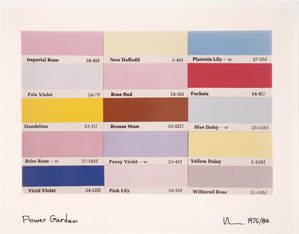Land Identity
|
Victor Landweber(American, b. 1943)
Flower Garden 1975, printed 1984 chromogenic color print UMFA1988.008.005 Notes from a curator! To create this artwork, Victor Landweber cut up, reorganized, and photographed paint swatches provided by the Treasure Tone company. Somewhat comically, Landweber compares his Treasure Tonesseries to the photographs of the Pictorialists. Like the turn-of-the-twentieth-century Pictorialists, Landweber was inspired by painting, and in the most literal sense, Flower Garden is a photograph of paint. Landweber also cites the work of color-focused Minimalist sculptors Donald Judd and John McCracken as influencing the series. Additionally, the orderly grid format and systematic execution of a preconceived idea—gathering all of the paint samples named after flowers in this example—align Treasure Tones with Conceptual art practices of the same era. --Whitney Tassie, Curator Modern and Contempory Art, Utah Museum of Fine Arts
|
Christian Eisele
The Great Salt Lake City (1893) oil on canvas 50.25″ x 108.25″ SMA2009.019 Notes about the artwork!Christian Eisele (1854-1919), a German itinerant painter, immigrated to the United States in 1869 and made several trips to Utah in the 1890s. He painted in a romantic, regional realism style and was known for his light-filled landscapes and perhaps better known in Utah for his detailed cityscapes. In this image, The Great Salt Lake City (1893), although you can pick out some of the major landmarks visible in Salt Lake Valley today, many of the buildings in this painting no longer exist. In addition, this area now has thousands more homes, roads, and businesses.
|

